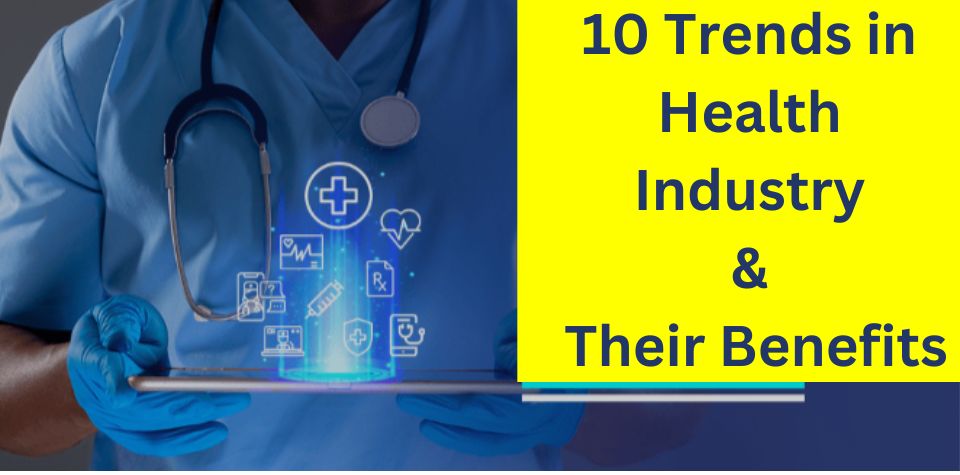The health industry is constantly changing and getting better to help people live longer. New ideas and technologies are continually being developed to improve our health and well-being.
Here, we have put together ten new-age trends shaping the health industry today.
Top 10 trends in healthcare
Healthcare AI
AI is improving healthcare by changing old, slow ways into quick and easy ways. It helps doctors and nurses take care of patients without needing to be there in person.
Many companies are creating software and digital tools to use AI. One big use is helping doctors and nurses keep track of patients and do office work faster.
AI helps make surgeries more accurate, which leads to better results for patients. It also allows doctors to find diseases early by looking at complex medical information.
This means patients can get the proper care sooner. Because of these benefits, the market for AI in healthcare is expected to grow a lot, reaching about $148.4 billion by 2029.
Benefits of AI in Healthcare
Accuracy: AI helps doctors make more accurate diagnoses. It can carefully analyze medical images like X-rays and MRIs, sometimes even better than the human eye.
It means doctors can find health problems earlier and with more certainty, making treatments more effective.
Efficiency: AI saves time and helps doctors work more efficiently. For example, AI can quickly sort through lots of medical records and data to find the critical information a doctor needs.
This means that professionals can spend more time with their patients and less time on paperwork.
Prediction: AI can predict health issues early, leading to better outcomes. By looking at patterns in data, AI can often tell when someone might get sick before they even have symptoms.
This early warning can help doctors start treatment sooner to make a big difference in a patient’s health.
Telemedicine
The COVID-19 pandemic made telemedicine much more popular with governments, hospitals, doctors, and patients. To handle the pandemic, governments created rules for using telemedicine to keep hospitals from getting too crowded.
Telemedicine helps by allowing doctors to talk to patients through video calls or voice calls. This way, doctors can help people without using a lot of personal protective equipment (PPE) and without everyone having to go to the hospital.
More about Telemedicine
Virtual doctor visits let patients get medical advice from home, so they don’t have to go to the clinic. Wearable health gadgets, like smartwatches, keep track of essential health signs and send the information to doctors who can monitor it instantly.
Plus, telemedicine platforms use AI to quickly and accurately check patient data, helping doctors find diseases early and plan the right treatments.
These technologies work together to make patient care better, make healthcare easier to get, and make medical processes smoother. Because of this, the telehealth and telemedicine market is expected to grow a lot, from USD 94.44 billion in 2023 to USD 286.22 billion by 2030.
Benefits of Telemedicine
Convenience: Telemedicine lets you talk to your doctor from your own home, which saves you from traveling to the doctor’s office. It means you can get medical advice without leaving your comfortable space and can schedule appointments more flexibly.
Safety: Using telemedicine lowers the chance of spreading infections, like during a flu season or other outbreaks. By not going to crowded waiting rooms, you are less likely to catch illnesses from others.
Accessibility: It’s easier for people living far away from hospitals or rural areas to see a doctor. They can use telemedicine to connect with healthcare providers without traveling long distances.
Immersive Technology
New technologies like AR (augmented reality), VR (virtual reality), and MR (mixed reality) are becoming more common in healthcare. VR is used for therapy to help people with brain and body problems get better. It’s also used for exposure therapy to treat anxiety.
In medical education, AR and VR are essential for giving students hands-on training that feels real and interactive. These technologies are changing how healthcare works and how doctors learn to help people.
Furthermore, these technologies are changing surgery by showing doctors patient information, holograms, and scans before and during surgery.
It makes surgeries more exact and quicker. These new tools are changing healthcare by improving treatments, helping doctors learn, and making surgeries smoother.
Benefits of Immersive Technology
Immersive technology, like virtual reality (VR) and augmented reality (AR), brings many benefits to healthcare:
Better Training: Doctors and medical students can practice surgeries and procedures in a realistic, safe way using VR and AR. This helps them get better at their jobs before working with real patients.
More Accurate Surgeries: Surgeons can use holographic images and detailed scans during operations to make surgeries more exact and successful, which helps patients recover faster.
Helps Therapy: VR is used in therapy to help patients recover from injuries or deal with anxiety. It lets them practice coping skills in a controlled environment.
Mobile Health [mHealth]
Mobile health technologies (mHealth) use phones and connected devices to give personalized health information. They let people see health problems and make decisions about their health without going to a doctor’s office.
These technologies work anywhere, using information that updates in real-time. Devices like wearable sensors and special tools for fast diagnosis and medical images make it easier for everyone to get the same good healthcare.
More about mHealth
During the COVID-19 pandemic, mobile health solutions were very important. They helped keep track of who had the virus, monitored people in quarantine, did testing, and shared important information.
They also helped track who got vaccinated and reminded people when they needed their next shot. These tools were essential in controlling the spread of the virus and keeping everyone safe.
Benefits of mHealth
Convenience: You can get health advice on your phone without going to the doctor.
Monitoring: It tracks your health and sends updates to your doctor.
Communication: It lets doctors talk to patients easily, no matter where they are.
Wearable Health Devices
Wearable health devices are gadgets like smartwatches and fitness trackers that you wear on your body. These devices can track your steps, heart rate, sleep patterns, and more. They help people monitor their health and fitness levels. Some devices can even alert you if something seems wrong, like a very high heart rate.
Benefits of Health Devices
Health Monitoring: These devices keep track of how active you are each day and check your health status regularly.
Motivation: They help motivate you to stay active and make healthy choices by giving you feedback on your progress.
Early Detection: Wearable devices can warn you early about possible health problems so you can get help sooner.
3D printing in Healthcare
3D printing is becoming more popular in healthcare. It’s used to make lightweight prosthetics, bionics (like robotic limbs), and casts for broken bones.
They use materials that are not expensive and are light, which makes healthcare better and makes things faster and cheaper to make.
3D printing improves healthcare by making models of organs and tools that fit each patient perfectly. Doctors use images from the patient’s own medical scans to create these models and tools.
It also helps make special surgical tools that make surgeries easier and faster, with better results for patients.
Benefits of 3D painting
Customization: It allows doctors to create personalized models of organs and tools based on a patient’s unique medical scans. This helps in planning surgeries more accurately.
Surgical Precision: Specialized surgical instruments made with 3D printing can improve a surgeon’s skill and make surgeries more precise. It may lead to better outcomes for patients with less pain and faster recovery.
Cost Efficiency: Using 3D printing can reduce the cost of making prosthetics, surgical tools, and other medical equipment. This makes healthcare more affordable for patients.
Blockchain
Blockchain technology is useful in healthcare because it keeps information secure and tracks it well. It’s used for things like keeping electronic medical records safe, monitoring patients from far away, making sure drugs get to the right places, and handling health insurance claims.
Blockchain technology helps manage electronic health records (EHRs) and a system called FHIRChain, which allows different health systems to share medical information quickly.
It also helps with smart contracts and fights against fake drugs. Blockchain keeps remote medical data safe and makes it easy to share and find when needed.
Benefits of Blockchain
Security: Blockchain keeps medical records safe from hackers and ensures that only authorized people may access them. It protects patients’ privacy and prevents fraud.
Transparency: It creates a transparent system where everyone involved can see the same information. This reduces errors and improves trust between patients, doctors, and insurers.
Data Integrity: Medical data stored on the blockchain is accurate and up-to-date. It cannot be changed without leaving a record, ensuring reliability for doctors and researchers.
Health Apps
Health apps are like tools you use on your phone or tablet to take care of your health. They help you keep track of things like what you eat, how much you exercise, and how well you sleep. Patients can also use them to remember to take their medicines on time.
Some of these apps let you talk to doctors or mental health experts through video calls or messages, which means you can get medical advice without going to the doctor’s office. These apps are designed to make it easier for you to stay healthy and get the help you need right from your device.
Benefits of Health Apps
Personalized Care: They help you track your health habits like diet, exercise, and sleep, giving you personalized advice to improve your well-being.
Convenience: You can manage your health from anywhere with your phone or tablet, making it easier to stay on top of your health goals.
Medication Management: Apps remind you to take your medicines on time and keep track of your prescriptions, reducing the risk of missing doses.
Also read: All You Need to Know About Sickle Cell Disease
Cloud Computing and Healthcare
Cloud computing helps doctors create better patient experiences using technology for remote healthcare and monitoring. It provides more space to store information and makes it easier to analyze data. Cloud computing also removes the need to keep data on-site, which saves time and money.
Cloud platforms bring together network services, security measures, billing systems, monitoring tools, and alerts. They also offer easy ways to access and manage identities. Cloud computing provides efficient ways to store, back up, and recover data. It uses smart technology to analyze data and share information between different systems.
Benefits of Cloud Computing
Improved Accessibility: Doctors and healthcare experts can access patient records and medical data from anywhere, making it easier to provide timely care and consultations.
Enhanced Collaboration: Cloud platforms allow healthcare teams to share information securely and collaborate more effectively, improving patient outcomes through better-coordinated care.
Cost Efficiency: It reduces the need for on-site servers and IT infrastructure, lowering maintenance costs and allowing healthcare facilities to invest more in patient care.
Digital Twins
A digital twin is like a virtual copy of something tangible, like a machine, place, or even a whole hospital. It helps us see how things work in different situations. For example, it can simulate a needle to understand how it behaves or an entire hospital to see how services are provided.
Scientists also create digital twins of parts of the human body, like organs. These help model what happens when treatments, medications, or lifestyle changes are made. One of the most challenging digital twins being worked on is a model of the human brain, which researchers aim to improve by 2024.
Benefits of Digital Twins
Personalized Medicine: They help doctors understand how treatments will affect individual patients based on their unique characteristics, improving treatment precision.
Simulation and Training: Healthcare experts can use digital twins to practice procedures and surgeries in a safe, virtual environment, enhancing skills and reducing risks during real operations.
Predictive Modeling: Digital twins can predict how diseases progress and how patients will respond to different treatments, helping doctors make better decisions about patient care.
Bottom Line
The healthcare industry is evolving rapidly with the help of innovative technologies. From artificial intelligence (AI) and telemedicine to 3D printing and blockchain, each trend reshapes how healthcare is delivered and experienced. These advancements are not just improving medical treatments and patient outcomes but also making healthcare more accessible and efficient for everyone.
As we look ahead, embracing these technologies will continue to pave the way for more personalized care, better training for healthcare experts, and enhanced predictive capabilities. The future of healthcare is bright, driven by these transformative trends that aim to create healthier communities and improve lives worldwide.
Also read: Over 800 HIV Cases and 47 Deaths Rise Health Tension in India












One thought on “10 Trends in Health Industry and Their Benefits”